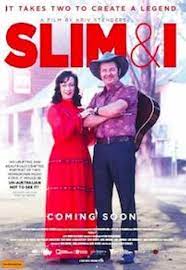SLIM AND I
Australia, 2020, 104 minutes, Colour.
Directed by Kriv Stenders.
 “The pub with no beer.”
“The pub with no beer.”
For those who have never heard of this song title, this documentary is a must, going back into Australia’s music history in the latter part of the 20th century, country music, folk music, songs as a voice for the rural community, songs as a bond between indigenous people and the latecomers to the land.
For those who recognise the title and associate it immediately with the singer, Slim Dusty, this will prove to be a very enjoyable documentary with more than a touch of nostalgia.
The writer-director of the film is Kriv Stenders, director of features, videos, documentaries and a number of feature films but, especially, the Red Dog films, two much loved films in Australia.
There was a feature film, The Slim Dusty Movie in 1984. This documentary draws on a number of sequences from this film, dramatising some of Slim Dusty’s early life and career.
However, while there is a portrait of Slim Dusty, very important is the I of the title. The I is his wife Joy McKean who is interviewed for this film, reminiscing, happy, sad, at the age of 90. In fact, this is very much a film about her, drawing on a memoir that she wrote, Slim and I, which is visualised, pages turning throughout this film. She is one of the two McKean sisters, Heather and Joy, the two interviewed for this film.
Joy was a prolific songwriter from an early age, then singing with her sister, performances, radio 2KY, well-known by the late 1940s and into the 1950s, the McKean sisters.
The film traces the relationship between Slim Dusty and Joy, meeting, singing, composing, performing, marrying, their two children, Anne and David, who are interviewed extensively throughout the film with many helpful memories explaining their parents. Anne was to join her parents in singing and tours.
There are also quite a number of impressive talking heads, singers and composers of country music from the past, their admiration for Slim Dusty and Joy, their songs, his performing them, the influence on their own careers. One of these is Chad Morgan, the well-known singer from the past with the protruding teeth! And, more contemporary, there are some comments from Missy Higgins and an interview with Keith Urban, and footage of him singing in performance with Slim Dusty. There are also interviews with music historians, talent promoters. They contribute well to the rounding of the picture of Slim Dusty.
And, the film also serves as something of an anthology of the many, many songs that he performed, and so many of them written by Joy. And, there is considerable footage from the past, of the family and their life, their different homes from Sydney to Metung, the extensive travel all around Australia over the years, their special presence at the local shows, the particular Western sideshow, characters, performances. And there is always Joy, and our being reminded sometimes of her disability, her calibre deadly and her limp. But, she emerges as the power behind the throne, skills in management and contracts, planning, and attention to all kinds of detail. And she has some moments, when she was pregnant with David, and two young blondes were employed for the performance and her warning Slim about his responsibilities to the family.
Slim was characterised by his hat, not recognised when he removed it! Loved singing, but he and Joy were ambitious and competitive, successful for many decades, and encouraging the upcoming generation. There is also talk of Slim Dusty’s restlessness, attempts to settle down, being in Sydney and record albums, his contract for many decades with EMI. But, he was always pleased to be on the road – and short tempered, suggestions that at times he had a rage.
In the middle of the documentary, there is a focus on Slim Dusty and Joy and their contact with indigenous peoples, their travels to the various towns, performances, their being well received and remembered, composing songs especially, Pepperminati, an invitation from teacher and later elderly Australian of the year, Miriam Rose Ungenmerr, inviting them to visit Daly River. The warmth with which the group was received by the indigenous communities, everybody joining in the singing, corrobberies performed for the guests, indicates how harmony can be achieved through music.
This is an important contribution to an appreciation of popular music in Australia, country and folk, the history of performance, Tamworth and other festivals, awards – and a satisfying experience of sitting and listening to Joy in her interviews, a wise woman reflecting at the age of 90.